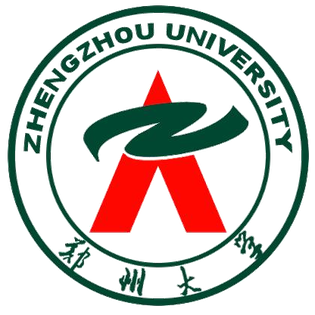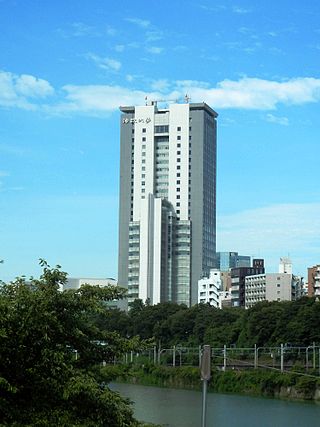
Tsinghua University (清华大学) is a public university in Haidian, Beijing, China. It is affiliated with and funded by the Ministry of Education of China. The university is part of Project 211, Project 985, and the Double First-Class Construction. It is also a member of the C9 League.
A geocode is a code that represents a geographic entity. It is a unique identifier of the entity, to distinguish it from others in a finite set of geographic entities. In general the geocode is a human-readable and short identifier.

Zhengzhou University is a provincial public university in Zhengzhou, Henan, China. It is affiliated with the Province of Henan. The university is part of Project 211 and the Double First-Class Construction.

The University of Shanghai for Science and Technology is a municipal public university in Yangpu, Shanghai, China. The university is affiliated with the City of Shanghai and funded by the Shanghai Municipal People's Government.
The Shanghai Institute of Technology (上海应用技术大学), also known as Shanghai Applied Technological University, is a municipal public application-orientated university in Fengxian, Shanghai, China. It is affiliated with the City of Shanghai and funded by the Shanghai Municipal People's Government.

Hosei University is a private research university in Chiyoda City, the heart of Tokyo, Japan. Hosei University is one of the most prestigious and well known private university regarded as comparable with the Tokyo-area elite selective private universities collectively known as "MARCH". It has an entrance examination difficulty level that is in the top 10 for a private university in Japan.

Toyo University is a private university with the main Hakusan campus in Bunkyo, Tokyo, Japan. The university operates multiple satellite campuses in the Kanto region, including. Asaka, Kawagoe, Itakura, and Akabane.

The Chengdu University of Technology is a national public research university located in Chengdu, Sichuan, China. It is a technology-focused institution co-funded by the Ministry of Education of China, the Ministry of Natural Resources of China, and the Sichuan Provincial People's Government. The university is part of the Double First-Class Construction.

Central South University is a public university in Changsha, Hunan, China. The university is affiliated with and funded by the Ministry of Education of China. It is part of Project 211, Project 985, and the Double First-Class Construction.

Project 985 was a higher education development and sponsorship scheme of the Chinese central government for creating world-class higher education institutions, initiated in May 1998. There were 39 universities selected to be part of this program.

Jiangnan University (江南大学) is a public university located in Wuxi, Jiangsu, China. It is affiliated with the Ministry of Education, and co-sponsored with the Jiangsu Provincial Government. The university is part of Project 211 and the Double First-Class Construction.
Wuyi University is a public university based in Jiangmen, Guangdong, China.
Guo Zhengtang is a Chinese geologist specialized in the Cenozoic.
ScienceNet is a science virtual community and science blog. It was launched by Science Times Media Group (STMG) and is supported by the Chinese Academy of Sciences, the Chinese Academy of Engineering, and the National Natural Science Foundation of China with the mission of establishing global Chinese science community. Since its launch on January 18, 2007, a total of 5,553 scientists and graduate students have blogged on ScienceNet.
Academic ranks in China are the titles, relative importance and power of professors, researchers, and administrative personnel held in academia.

Liu Yan is a Chinese Antarctic researcher best known for her work on iceberg calving. She is an associate professor of geography in the College of Global Change and Earth System Science (GCESS) and Polar Research Institute, Beijing Normal University.
Meng Wei is a former Chinese politician and environmentalist who served as president of the Chinese Research Academy of Environmental Sciences from 2001 to 2016. As of November 2017 he was under investigation by the Communist Party's anti-corruption agency. He was an academician of the Chinese Academy of Engineering. He was a deputy to the 11th and 12th National People's Congress. He was the first notable figure implicated in corruption following the 19th National Congress of the Chinese Communist Party on October 24, 2017. He is the third academician of the Chinese Academy of Engineering whose title has been revoked in the past two years, after Li Ning and Zhou Guotai. Meng Wei has been stripped of his post and party membership on April 4, 2018.

TMSR-LF1 is a 2 MWt molten salt reactor (MSR) pilot plant located in northwest China.

Ji Jiafu FACS, FRCS is a Chinese surgical oncologist and researcher specializing in gastrointestinal malignancy. He is a professor in gastrointestinal surgery at Peking University, the director of the Key Laboratory in "Malignancy Pathogenesis and Translational Research" under the Ministry of Education of the People's Republic of China, a fellow of the Chinese Academy of the Medical Sciences (CAMS), and a recipient of the Special Government Allowances of the State Council.

Graduate School of Engineering and Faculty of Engineering (京都大学大学院工学研究科・工学部) is one of schools at the Kyoto University. The Faculty (Undergraduate) and the Graduate School operate as one.












